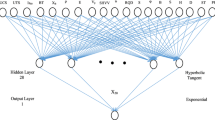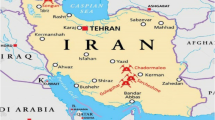Abstract
Prediction of rock fragmentation is essential for optimizing blasting operation. Fragmentation depends on many parameters such as rock mass properties, blast geometry and explosive properties. In this paper, artificial neural network (ANN) method is implemented to develop a model to predict rock fragmentation due to blasting in an iron ore mine. In the developing of the proposed model eight parameters such as hole diameter, burden, powder factor, blastability index, etc., were incorporated. Training of the model was performed by back-propagation algorithm using 220 datasets. A four-layer ANN was found to be optimum with architecture 10-9-7-1. Sensitivity analysis revealed that the most effective parameters on rock fragmentation are blastability index (G), charge per delay (J), burden (C), SMR (F) and powder factor (E).





Similar content being viewed by others
References
Bozic B (1998) Control of fragmentation by blasting. Min Petrol Eng Bull 10:49–57
Morin MA, Francesco F (2006) Monte Carlo simulation as a tool to predict blasting fragmentation based on the Kuz–Ram model. J Comput Geosci 32:352–359
Thornton D, Kanchibolta SS, Brunton I (2002) Modelling the impact and blast design variation on blast fragmentation. Int J Blast Fragment 6(2):169–188
Hustrulid W (1999) Blasting principles for open pit mining, vol 1. Balkema, Rotterdam
Kanchibotla S (2001) Optimum blasting? Is it minimum cost per broken rock or maximum value per broken rock? In: Proceedings of Explo, Australasian Institute of Mining and Metallurgy
Michaux S, Djordjevic N (2005) Influence of explosive energy on the strength of the rock fragments and SAG mill throughput. Int J Miner Eng 18:439–448
Tawadrous A (2006) Evaluation of artificial neural networks as a reliable tool in blast design. Int Soc Explos Eng 1:1–12
Khandelwal M, Roy MP, Singh PK (2004) Application of artificial neural network in mining industry. Indian Min Eng J 43:19–23
Khandelwal M, Singh TN (2005) Prediction of blast induced air overpressure in opencast mine. J Noise Vib Worldw 36:7–16
Monjezi M, Dehghani H (2008) Evaluation of effect of blasting pattern parameters on back break using neural networks. Int J Rock Mech Min Sci 45:1446–1453
Khandelwal M, Singh TN (2006) Prediction of blast induced ground vibrations and frequency in opencast mine–a neural network approach. J Sound Vib 289:711–725
Singh VK, Singh D, Singh TN (2001) Prediction of strength properties of some schistose rock. Int J Rock Mech Min Sci 38:269–284
Kahraman S, Altun H, Tezekici BS, Fener M (2006) Sawability prediction of carbonate rocks from shear strength parameters using artificial neural networks. Int J Rock Mech Min Sci 43:157–164
Fener M, Kahraman S, Ozder MO (2007) Performance prediction of circular diamond saws from mechanical rock properties in cutting carbonate rocks. J Rock Mech Rock Eng 40:505–517
Monjezi M, Rezaei M, Yazdian A (2009) Prediction of backbreak in open-pit blasting using fuzzy set theory. J Expert Syst Appl 37:2637–2643
Snedecor GW, Cochran WG (1956) Statistical methods applied to experiments in agriculture and biology, 5th edn. Iowa State University Press, Ames, Iowa
Student (1923) On testing varieties of cereals. Biometrika 15:271–293
Levitt SD, List JA (2009) Field experiments in economics: the past, the present, and the future. Eur Econ Rev 53:1–18
Wasserman PD (1989) Neural computing theory and practice. Van Nostrand Reinhold, New York
Limpon RP (1987) An introduction to computing with neural nets. IEEE ASSP Magazine, pp 4–22
Kosko B (1958) Neural networks and fuzzy system, a dynamical system approach to machine intelligence. Prentice–Hall, Englewood Cliffs
Nielsen RH (1998) Neurocomputing, picking the human brain. IEEE 3:36–41
Neaupanea KM, Achet SH (2004) Use of backpropagation neural network for landslide monitoring: a case study in the higher Himalaya. J Eng Geol 74:213–226
Anderson JA (1995) An introduction to neural networks. MIT Press, Cambridge, MA, pp 672. ISBN: 10:0262011441
Chauvin Y, Rumelhart DE (1995) Backpropagation: theory, architectures and applications. Erlbaum, Mahwah, NJ, pp 561. ISBN: 080581258X
Alsmadi MKS, Omar KB, Noah SA (2009) Back propagation algorithm: the best algorithm among the multi-layer perceptron algorithm. Int J Comput Sci Netw Secur 9:378–383
Chandok JS, Kar IN, Tuli S (2008) Estimation of furnace exit gas temperature (FEGT) using optimized radial basis and back-propagation neural networks. J Rock Energy Convers Manag 49:1989–1998
Monjezi M, Yazdian A, Hesami SM (2006) Use of back propagation neural network to estimate burden in tunnel blasting. J Mines Metals Fuels 54:424–429
Monjezi M, Bahrami A, Yazdian A, Sayadi AR (2009) Prediction and controlling of flyrock in blasting operation using artificial neural network. Arab J Geoscis. doi:10.1007/s12517-009-0091-8
Monjezi, M, Bahrami A, Yazdian A (2009) Simultaneous prediction of fragmentation and flyrock in blasting operation using artificial neural networks. Int J Rock Mech Min Sci. doi:10.1016/j.ijrmms.2009.09.008
Yang Y, Zhang Q (1997) A hierarchical analysis for rock engineering using artificial neural networks. J Rock Mech Rock Eng 30:207–222
Lu Y (2005) Underground blast induced ground shock and its modeling using artificial neural network. J Comput Geotech 32:164–178
Jong YH, Lee CI (2004) Influence of geological conditions on the powder factor for tunnel blasting. Int J Rock Mech Min Sci 41:533–538
Author information
Authors and Affiliations
Corresponding author
Rights and permissions
About this article
Cite this article
Bahrami, A., Monjezi, M., Goshtasbi, K. et al. Prediction of rock fragmentation due to blasting using artificial neural network. Engineering with Computers 27, 177–181 (2011). https://doi.org/10.1007/s00366-010-0187-5
Received:
Accepted:
Published:
Issue Date:
DOI: https://doi.org/10.1007/s00366-010-0187-5




